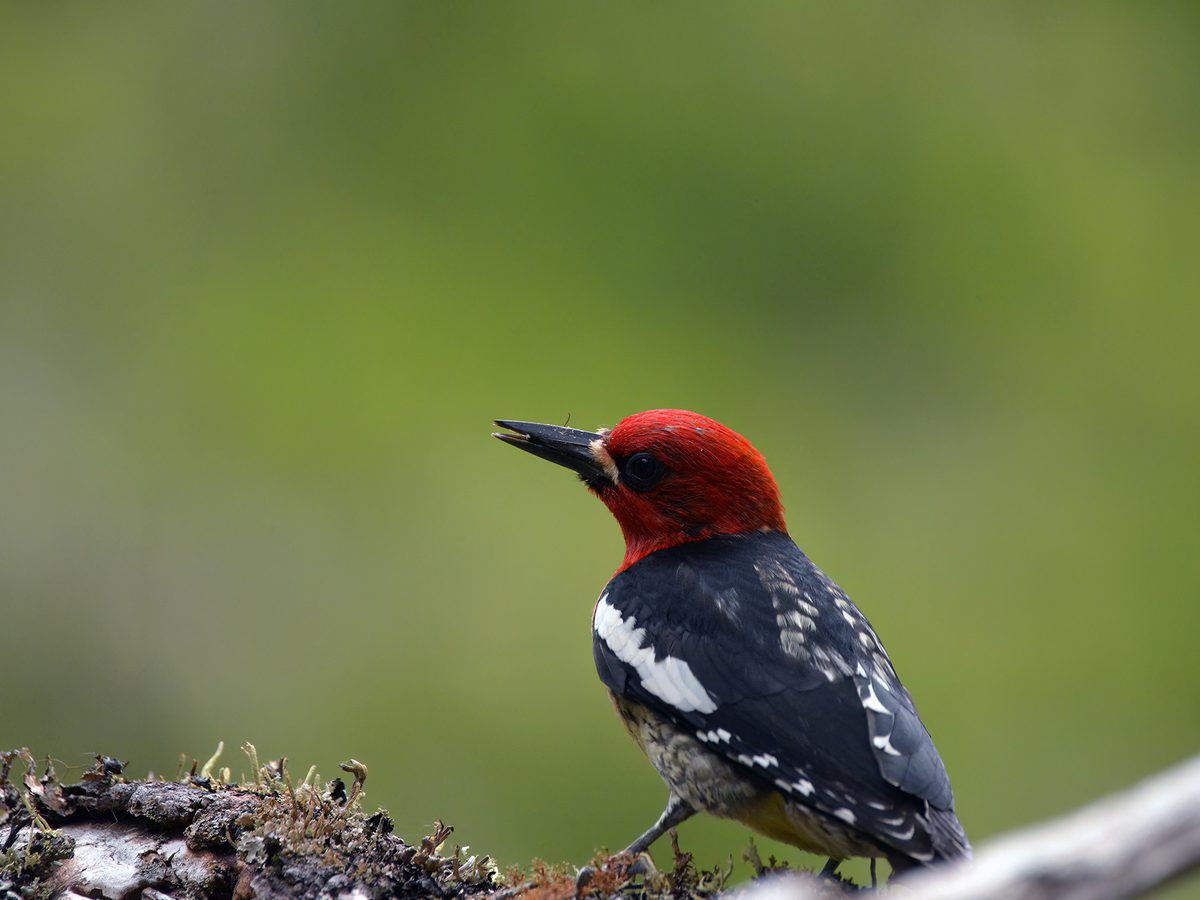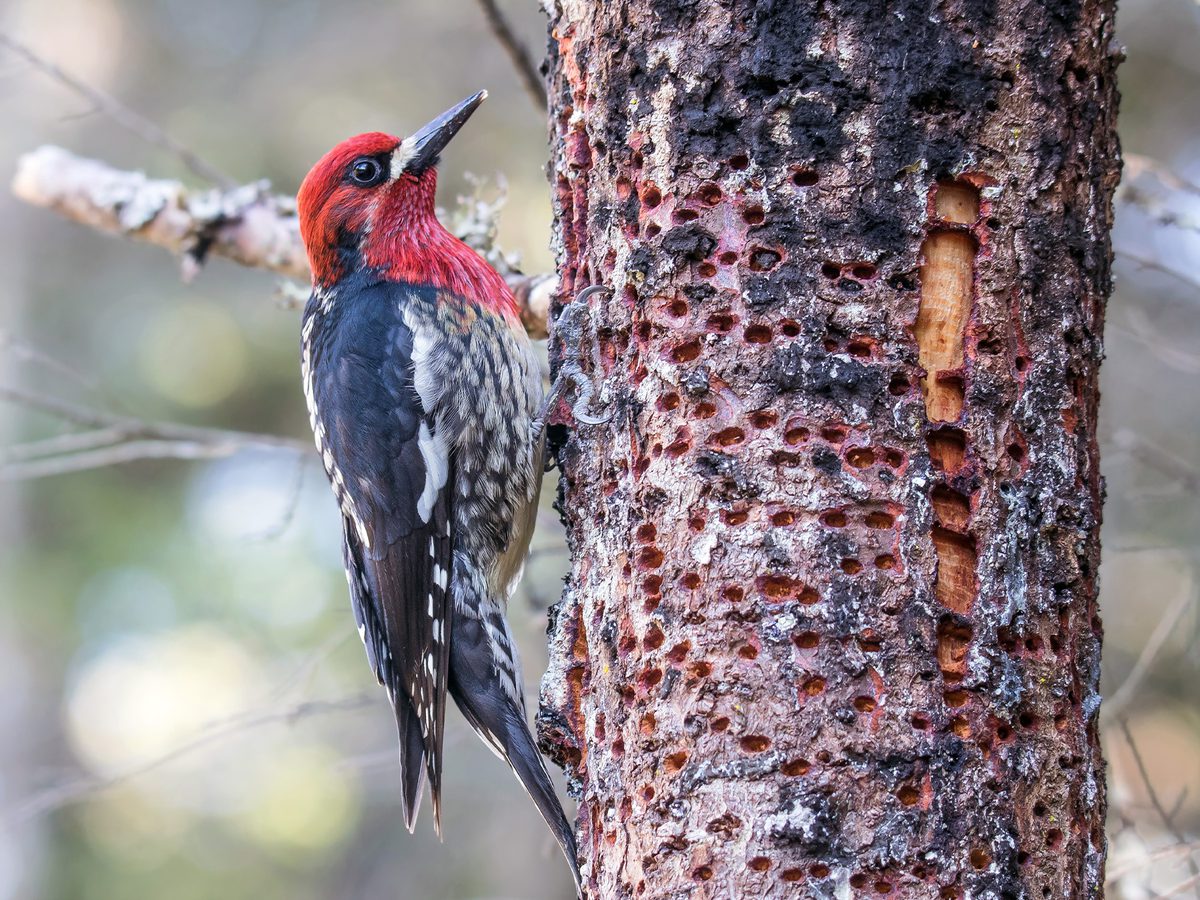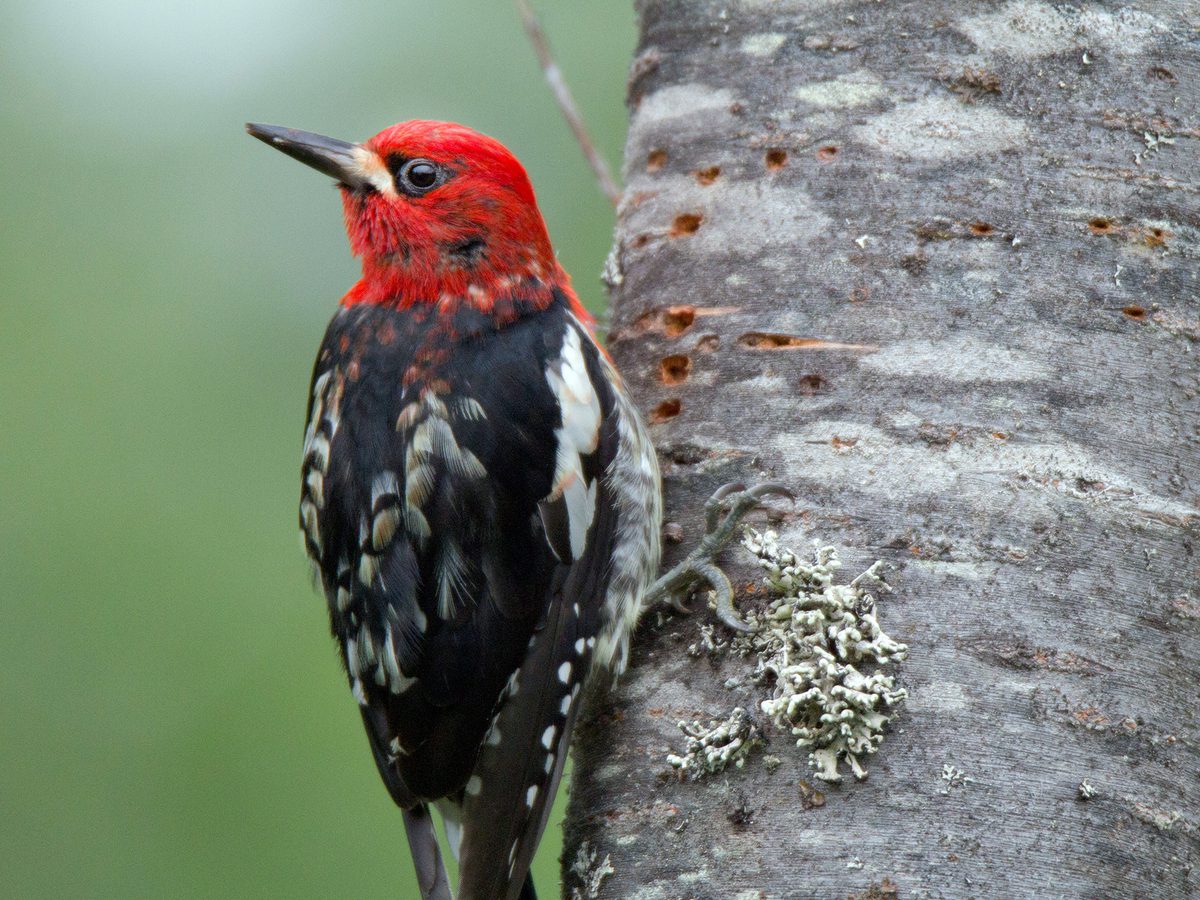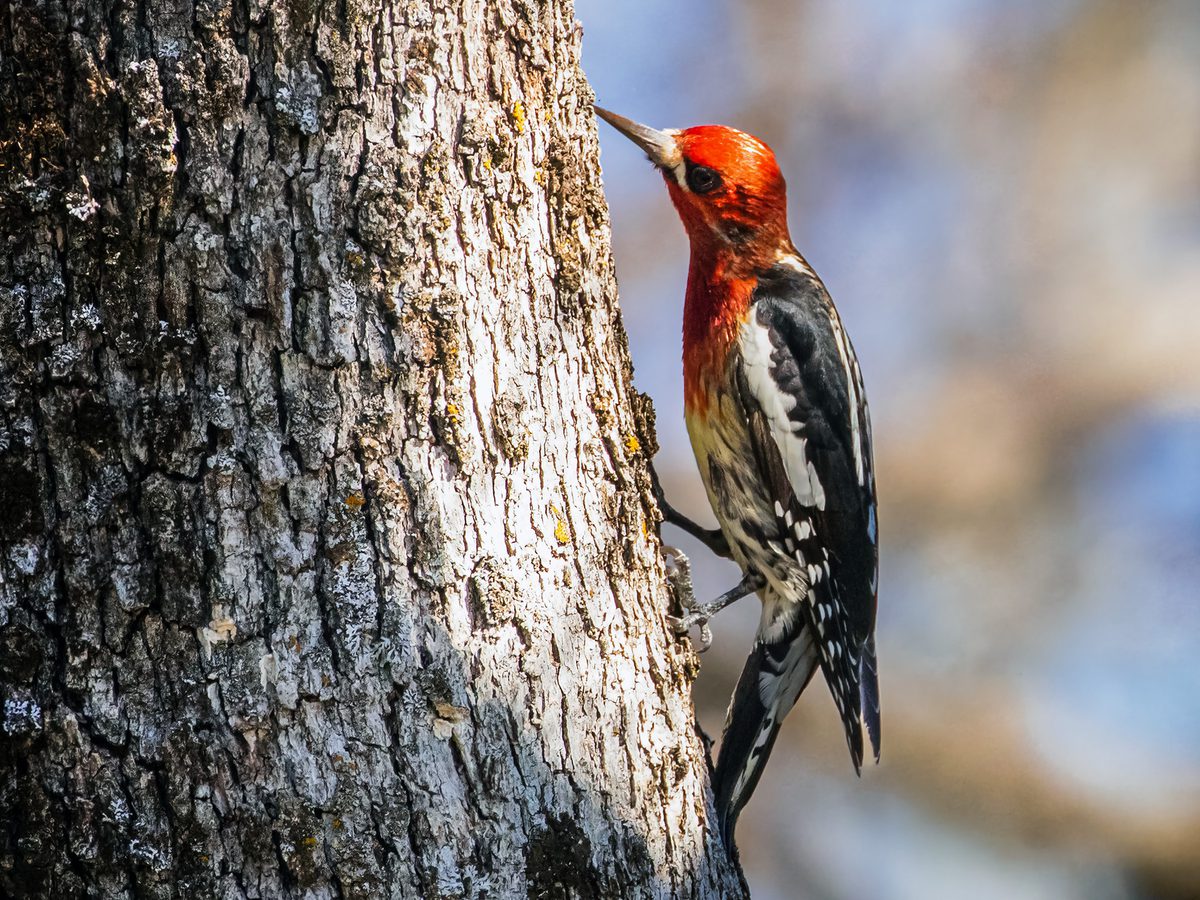Red-breasted Sapsucker
Native to the western coastal regions of North America, red-breasted sapsuckers are unmistakable woodland birds with a crimson head and breast and bold white shoulder stripe. Perhaps what makes them more remarkable still are the neat rows of holes they drill into trunks of trees to access the sweet sap inside.
Appearance & Identification
What do Red-breasted Sapsuckers look like?
Male red-breasted sapsuckers are boldly colored with a red head and facial plumage that extends into the upper breast and to the nape. Their back is black, with small yellow spots, a distinct white shoulder patch, black wings with light yellow spotting, a white rump, and a black tail.
Below the scarlet upper breast, the lower breast and belly are yellow, marked on the flanks with black spots, and the underparts are yellowish-white. A white bar is present across the top of the bill, which is horn gray and slightly upturned.
In female red-breasted sapsuckers, the red coloring is less vibrant, and their heads are paler red, washed with white markings. The breast is also a patchier red, and their backs and wings feature more light-colored patterning than seen in males.
Juvenile red-breasted sapsuckers are darker than adults but have the same visible white wing patches seen in mature birds. Instead of the bold red coloring of adult birds, young red-breasted sapsuckers have brown feathers on their heads, and the breast is lighter brownish-buff, mottled with heavy brown markings.
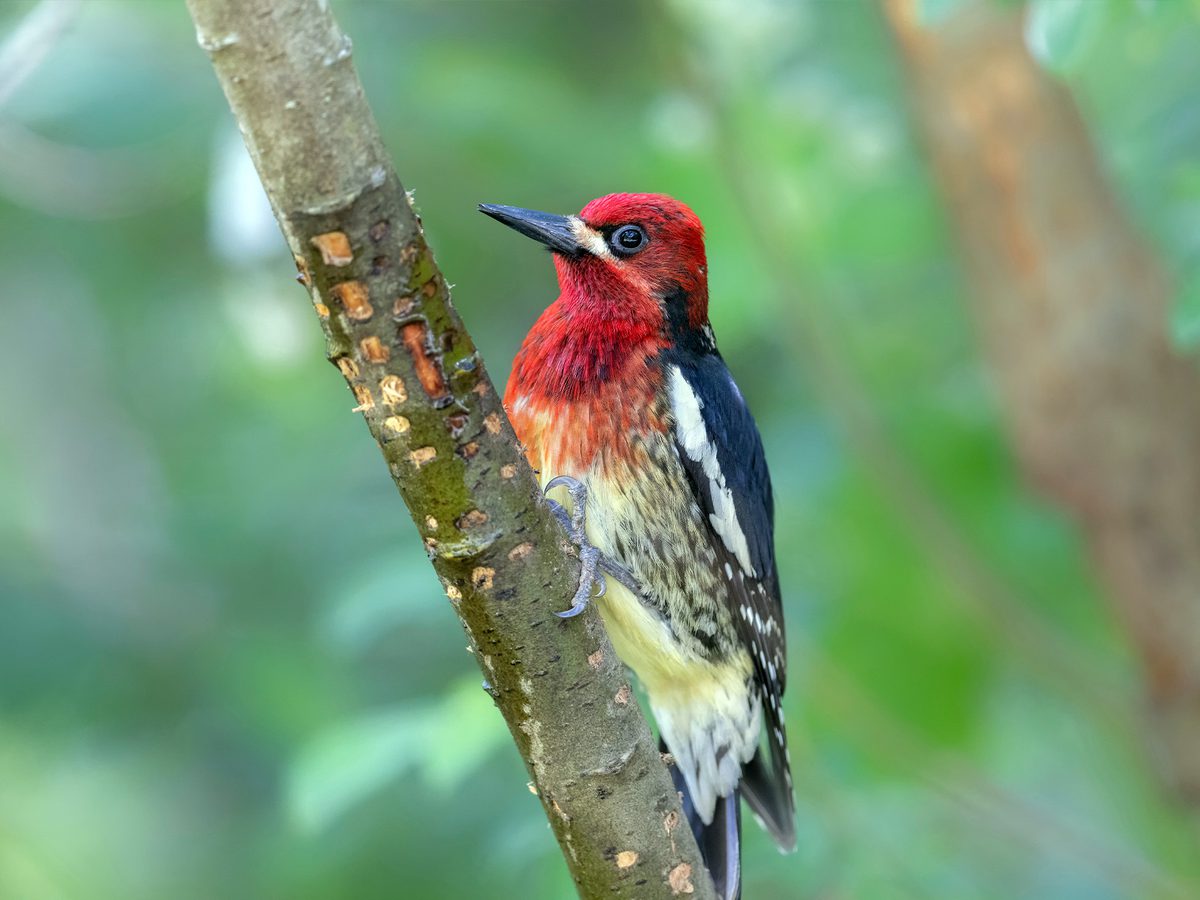
Sign up for the Birdfact Newsletter!
Enjoying our content and want more of it in your inbox? Sign up for our newsletter to get bird facts straight to your inbox.
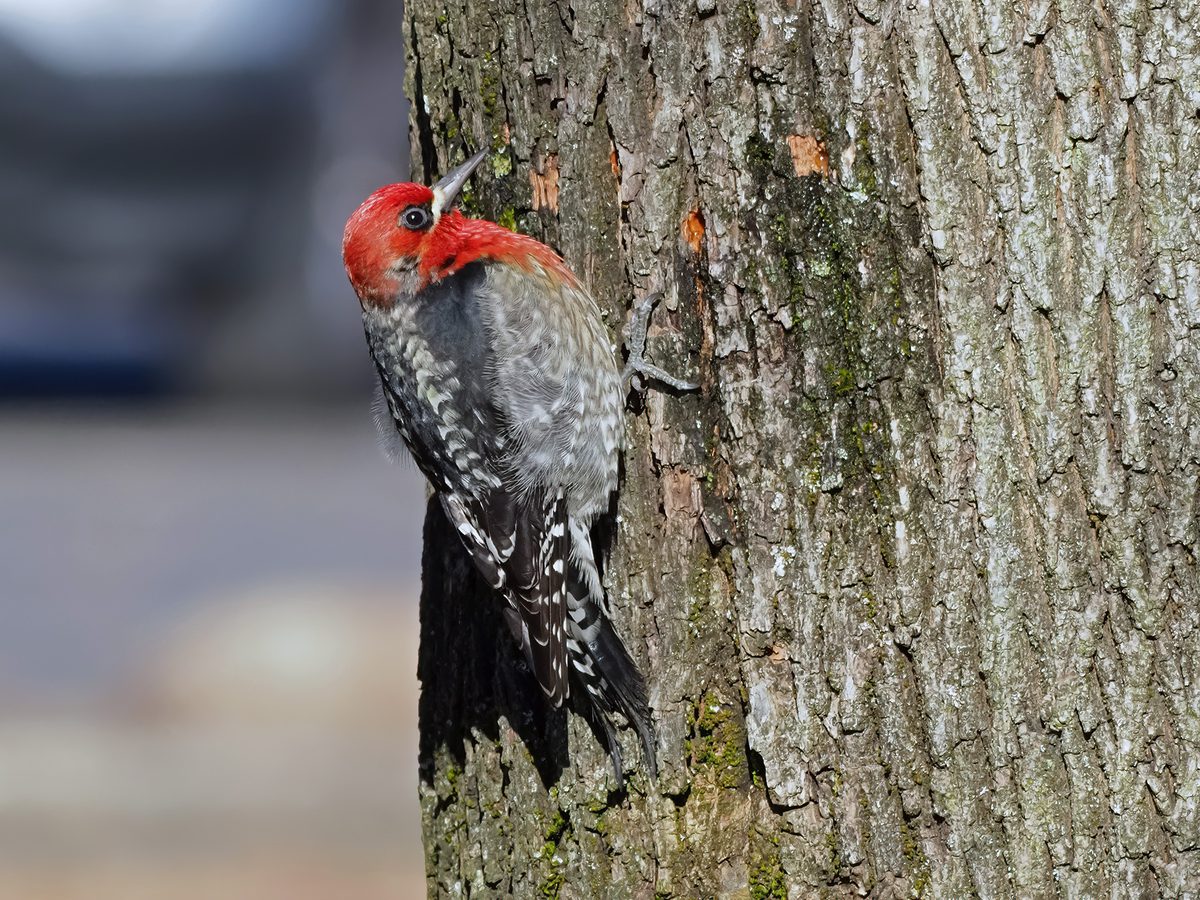
Calls & Sounds
What sound does a Red-breasted Sapsucker make?
Red-breasted sapsuckers make a low, rasping call, with harsh notes and repeated phrases. A ‘waa’ call is used to signal distress and warning, particularly when a threat is detected nearby. Nasal squealing calls are heard between pairs.
Both sexes use drumming to communicate, with the species being associated with a slow and irregular pace.
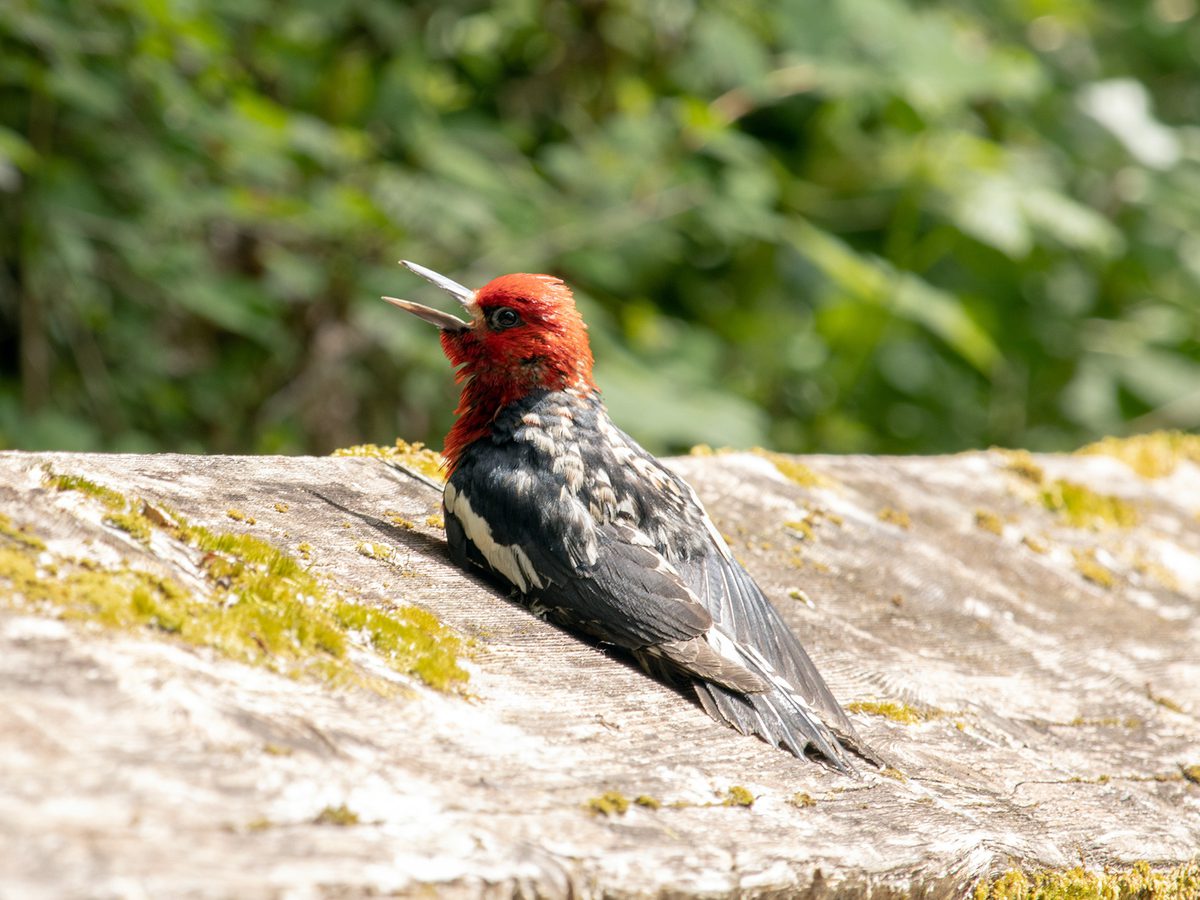
What do Red-breasted Sapsuckers eat?
The main food of red-breasted sapsuckers is sap. They drill out horizontal rows of ‘sap wells’ in tree trunks to access the internal sap, and to ensure it continues to flow, they use a system of rectangular and circular holes.
Their tongues are shorter than those of other woodpeckers, and specially adapted with barbed edges at the tip, which helps them to extract as much sap as possible.
Fruit, seeds, and tree cambium are also eaten. Insects are sometimes caught in flight, as well as caught in sap (particularly ants).
What do Red-breasted Sapsucker chicks eat?
Invertebrates, especially ants, are the chief food of young red-breasted sapsuckers. Insects fed to young are often dipped in sap, to provide extra energy. Spiders, caterpillars, and flies are also important in a young red-breasted sapsucker’s diet.
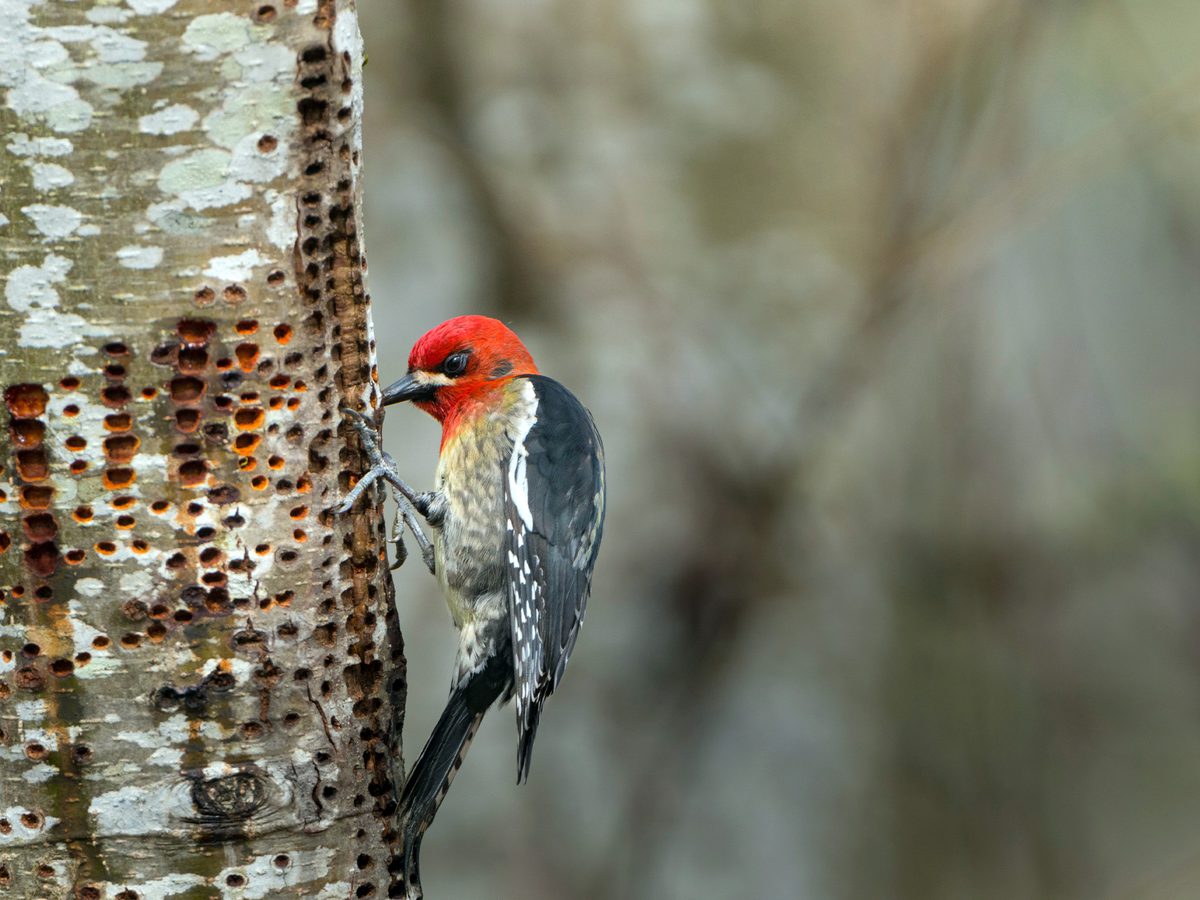
Habitat & Distribution
What is the habitat of a Red-breasted Sapsucker?
Pine forests, at elevations of up to 2900 m (9500 ft) offer ideal breeding grounds for red-breasted sapsuckers.
Preferred tree species include white pine, lodgepole pine, white fir, hemlock, Douglas fir and spruce. Some mixed deciduous woodlands may also attract breeding red-breasted sapsuckers, particularly along rivers and streams, where cottonwood and quaking aspen are favored.
Outside of the breeding season, lowland environments dominate, with many red-breasted sapsuckers moving from inland forests toward coastal woodland habitats.
What is the range of a Red-breasted Sapsucker?
Red-breasted sapsuckers are confined to the westernmost region of North America, with a range that extends from the southern coastal regions of Alaska and British Columbia in the north, southwards through western Washington, Oregon, and into California. In winter, northern breeders temporarily relocate as far south as the northern part of Baja California.
Interior uplands of British Columbia and northern California are popular as breeding grounds, with populations moving towards lowland coastal regions as summer ends.
Where do Red-breasted Sapsuckers live?
Oregon’s Douglas fir forests in the Coastal Ranges to the south of the state have the largest concentrations of red-breasted sapsuckers.
How rare are Red-breasted Sapsuckers?
Within much of their range, red-breasted sapsuckers are relatively common and widespread, with an estimated overall population of 2.3 million individuals. In the south of the range, they are fairly common in the
Where can you see Red-breasted Sapsuckers in the US?
Washington’s Mount Rainier National Park is a known spot for red-breasted sapsuckers, with its rich forests offering an ideal habitat. Look for their rows of neatly drilled out sap wells in tree trunks.
Spring is a particularly good time of year for sightings as the increased activity levels at nest sites with regular feeding visits to nestlings make them more visible than usual.
Where can you see Red-breasted Sapsuckers in Canada?
Canada’s population of red-breasted sapsuckers is based entirely in British Columbia. During the breeding season, their range extends inland and they are found mostly in aspen, willow, and birch trees among mixed coniferous-deciduous woodlands. Regular sightings are reported to the west of the Cascade Ranges.
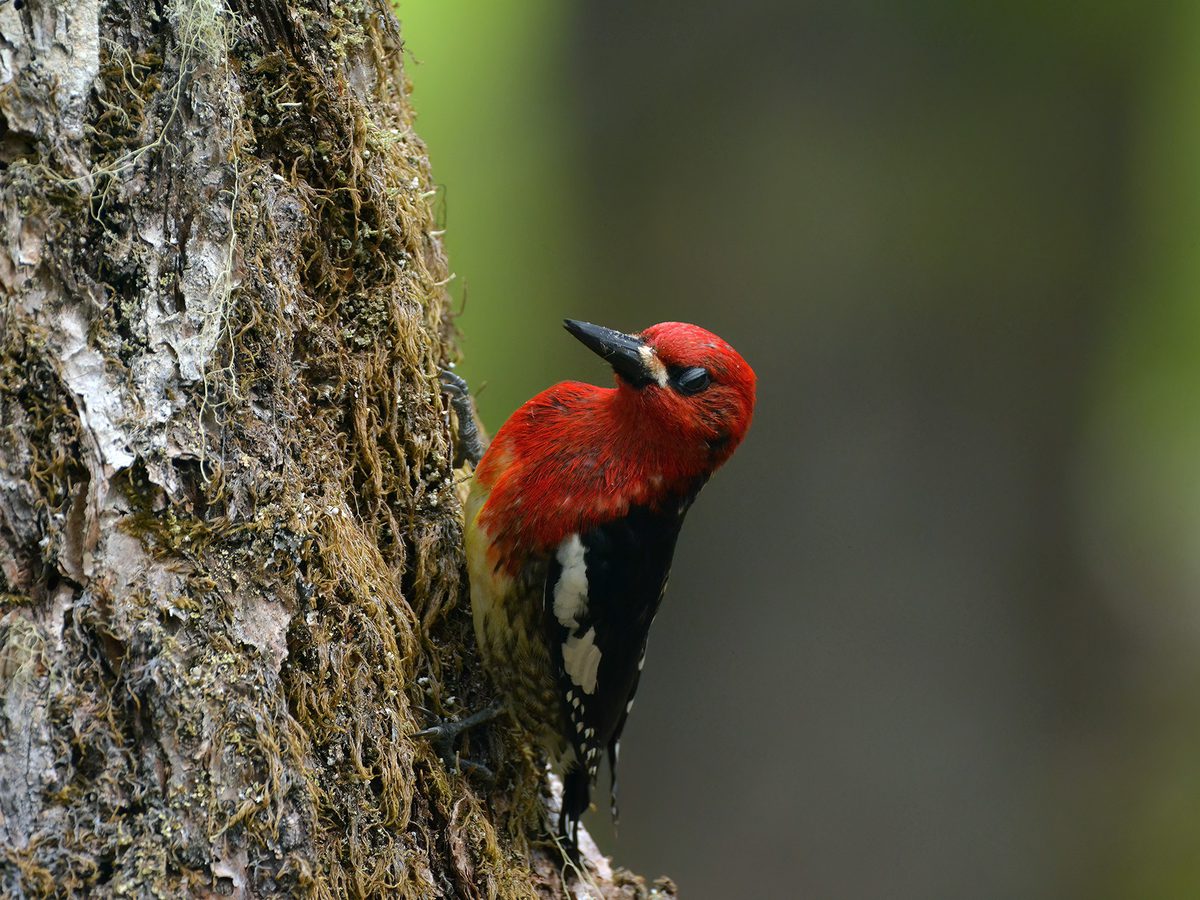
Red-breasted Sapsucker in woodland habitat
Lifespan & Predation
How long do Red-breasted Sapsuckers live?
On average, red-breasted sapsuckers have an expected lifespan of between 2 and 3 years and usually breed for the first time at one year old. The oldest recorded individual was identified from a banding program having reached 5 years of age.
Are Red-breasted Sapsuckers protected?
Red-breasted sapsuckers were once extensively hunted for their colorful feathers or shot as a pest in orchards, which led to population declines in the late 19th century. The Migratory Bird Treaty Act of 1918 has given the species protection against being killed, injured, captured, or traded, and also extends these conditions to their eggs, feathers, nests and their young.
Are Red-breasted Sapsuckers endangered?
Currently listed as a species of least concern, red-breasted sapsucker populations are considered stable in much of their range, with increases apparent in Oregon at the end of the 20th century. In California, however, some slight declines in numbers were recorded.
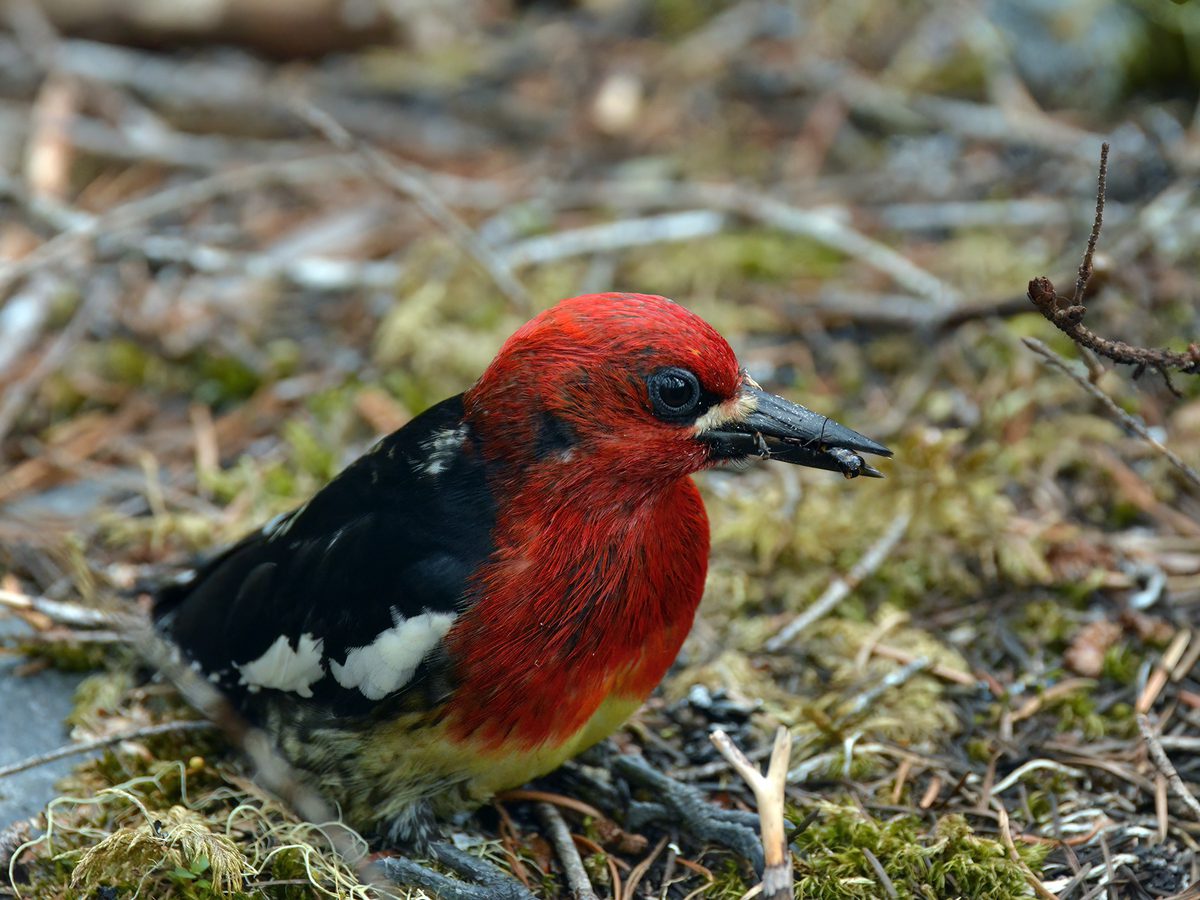
Red-breasted Sapsucker foraging on the forest ground
Nesting & Breeding
Where do Red-breasted Sapsuckers nest?
Nest cavities are usually constructed in snags or dead or decaying trees. A variety of both deciduous and coniferous species are used for nesting, including western hemlock, white pine, cottonwood, Douglas fir, quaking aspen, broadleaf maple and spruce.
Males do the bulk of the cavity excavation, assisted by the female, with sites on average 30 m above ground. Cavities are lined with wood chips, but no additional material is added, and nests are not reused in subsequent years.
When do Red-breasted Sapsuckers nest?
Cavity construction begins in April to May, with the earliest eggs observed to be laid in late April. Incubation, shared between males and females, lasts for at least 11 days, but 14 to 15 days is most common.
Eggs are barely left unattended, with males remaining in the cavity overnight, and alternating with females during the day. Young red-breasted sapsuckers are ready to leave the nest after between 23 and 28 days.
What do Red-breasted Sapsucker eggs look like?
Between 4 and 7 plain white eggs are laid by red-breasted sapsuckers. Eggs measure 23 mm by 18 mm (0.9 in by 0.7 in). One single clutch is laid each season. If a clutch fails early in the breeding season, it’s likely that a replacement brood will be attempted in a different cavity.
Do Red-breasted Sapsuckers mate for life?
Red-breasted sapsuckers are monogamous during the breeding season and maintain a pair bond until their young gain independence. Pairs may reunite in the following breeding season if both mates have survived the winter.
